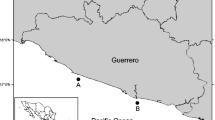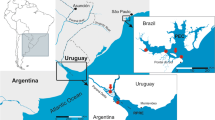Abstract
With the aim of knowing the distribution of As, Hg, and Se in skipjack (Katsuwonus pelamis, Linnaeus, 1758) and yellowfin tuna (Thunnus albacares, Bonnaterre, 1788) from the Eastern Pacific, elemental concentrations were determined in the muscle and liver; As species were also analyzed in the stomach content. Additionally, health risk for consumers was assessed. For both tunas, levels of As and Se were significantly higher (p < 0.05) in the liver than in the muscle. In K. pelamis, Hg concentrations in the muscle were significantly higher (p < 0.05) than those in the liver. In T. albacares, As, Hg, and Se showed a trend to increase with fish dimensions. Arsenic extractability was better in the muscle than in the liver of both species; in K. pelamis, As species were better extracted than in T. albacares. In both tuna species, the most extractable arsenic was arsenobetaine (AsB) and a minor part was dimethylarsinic acid (DMA). The liver contained mainly AsB with some DMA and arsenocholine (AsC). Hazard indexes (HI) indicated no risk from Hg and Se intake through these tuna species. Considering the individual contribution to the HI, Hg contributed more (80 to 86%) than Se. In the context of health risk, none of the As and Hg values were above the permissible limits; however, two samples of T. albacares (9%) and three samples of K. pelamis (12%) had Se concentrations over the limits. If Hg and Se in the edible portion of tuna are considered under the approach of the HBVSe, tuna consumption is beneficial.




Similar content being viewed by others
References
Allen GR, Bauchot ML, Bellwood DR, Bianchi G (1995) Peces óseos. In: Fischer W, Krupp F, Schneider W, Sommer C, Carpenter KE, Niem VH (eds) Guía FAO para la identificación de especies para los fines de la pesca. Pacífico centro-oriental Volumen II. Vertebrados Parte 1. FAO, Rome, pp 1201–1813
Araújo CVM, Cedeño-Macías LA (2016) Heavy metals in yellowfin tuna (Thunnus albacares) and common dolphinfish (Coryphaena hippurus) landed on the Ecuadorian coast. Sci Total Environ 541:149–154. https://doi.org/10.1016/j.scitotenv.2015.09.090
Barwick M, Maher W (2003) Biotransference and biomagnification of selenium, copper, cadmium, zinc, arsenic and lead in a temperate seagrass ecosystem from lake Macquarie estuary, NSW, Australia. Mar Environ Res 56:471–502. https://doi.org/10.1016/S0141-1136(03)00028-X
Bodin N, Lesperance D, Albert R, Hollanda S, Michaud P, Degroote M, Churlaud C, Bustamante P (2017) Trace elements in oceanic pelagic communities in the western Indian Ocean. Chemosphere 174:354–362. https://doi.org/10.1016/j.chemosphere
Burger J, Gochfeld M (2005) Heavy metals in commercial fish in New Jersey. Environ Res 99(3):403–412. https://doi.org/10.1016/j.envres.2005.02.001
Burger J, Jeitner C, Gochfeld M (2011) Locational differences in mercury and selenium levels in 19 species of saltwater fish from New Jersey. J Toxicol Environ Health A 74(13):863–874. https://doi.org/10.1080/15287394.2011.570231
Cardoso C, Bandarra N, Lourenço H, Afonso C, Nunes M (2010) Methylmercury risk and EPA+DHA benefits associated with seafood consumption in Europe. Risk Anal 30:827–840. https://doi.org/10.1111/j.1539-6924.2010.01409.x
Caumette G, Koch I, Reimer KJ (2012) Arsenobetaine formation in plankton: a review of studies at the base of the aquatic food chain. J Environ Monit 14:2841–2853. https://doi.org/10.1039/c2em30572k
Collette BB, Nauen CE (1983) An annotated and illustrated catalogue of tunas, mackerels, bonitos and related species known to date. In: FAO Fisheries Synopsis, FAO Species Catalogue, Scombrids of the world Food and Agriculture Organization of the United Nations, Rome, pp 1–42, vol. 2, no. 125
Cuvin-Aralar LM, Furness RW (1991) Mercury and selenium interaction: a review. Ecotoxicol Environ Saf 21:348–364. https://doi.org/10.1016/0147-6513(91)90074-Y
Endo T, Hisamichi Y, Haraguchi K, Kato Y, Ohta C, Koga N (2008) Hg, Zn and cu levels in the muscle and liver of tiger sharks (Galeocerdo cuvier) from the coast of Ishigaki Island, Japan: relationship between metal concentrations and body length. Mar Pollut Bull 56:1774–1780. https://doi.org/10.1016/j.marpolbul.2008.06.003
García-Hernández J, Cadena-Cárdenas L, Betancourt-Lozano M, García-de-la-Parra LM, García-Rico L, Márquez-Farías F (2007) Total mercury content found in edible tissues of top predator fish from the Gulf of California, Mexico. Environ Toxicol Chem 89:507–522. https://doi.org/10.1080/02772240601165594
Gochfeld M (2003) Cases of mercury exposure, bioavailability, and absorption. Ecotoxicol Environ Saf 56:174–179. https://doi.org/10.1016/S0147-6513(03)00060-5
Honda S, Hylander L, Sakamoto M (2006) Recent advances in evaluation of health effects on mercury with special reference to methylmercury—a minireview. Environ Health Prev Med 11:171–176. https://doi.org/10.1007/BF02905275
Husain A, Kannan K, Chan HM, Laird B, Al-Amiri H, Dashti B, Sultan A, Al-Othman A, Mandekar B (2017) A comparative assessment of arsenic risks and the nutritional benefits of fish consumption in Kuwait: arsenic versus omega 3-fatty acids. Arch Environ Contam Toxicol 72:108–118. https://doi.org/10.1007/s00244-016-0329-x
Jinadasa BKKK, Ahmad SBN, Edirisinghe EMRKB, Wicramasinghe I (2015) Mercury content in yellowfin tuna (Thunnus albacares) and swordfish (Xiphias gladius) and estimation of mercury intake. J Food Secur 2:23–26. https://doi.org/10.12691/jfs-2-1-3
Kaneko JJ, Ralston NV (2007) Selenium and mercury in pelagic fish in the central North Pacific near Hawaii. Biol Trace Elem Res 119(3):242–254. https://doi.org/10.1007/s12011-007-8004-8
Kennish MJ (1998) Pollution impacts on marine biotic communities. CRC Press, Boca Raton
Kitchell J, Essington T, Boggs C, Schindler D, Walters C (2002) The role of sharks and longline fisheries in a pelagic ecosystem of the Central Pacific. Ecosystems 5:202–216. https://doi.org/10.1007/s10021-001-0065-5
Kojadinovic J, Potier M, Le Corre M, Cosson RP, Bustamante P (2007) Bioaccumulation of trace elements in pelagic fish from the Western Indian Ocean. Environ Pollut 146(2):548–566. https://doi.org/10.1016/j.envpol.2006.07.015
Kristan U, Kanduč T, Osterc A, Šlejkovec Z, Ramšak A, Stibilj V (2014) Assessment of pollution levels using Mytilus galloprovincialis as a bioindicator species: the case of the Gulf of Trieste. Mar Pollut Bull 89:455–463. https://doi.org/10.1016/j.marpolbul.2014.09.046
Liu LH, Yun ZJ, He B, Jiang GB (2014) Efficient interface for online coupling of capillary electrophoresis with inductively coupled plasma-mass spectrometry and its application in simultaneous speciation analysis of arsenic and selenium. Anal Chem 86:8167–8175. https://doi.org/10.1021/ac501347d
Looi LJ, Aris AZ, Haris H, Yusoff FM, Hashim Z (2016) The levels of mercury, methylmercury and selenium and the selenium health benefit value in grey-eel catfish (Plotosus canius) and giant mudskipper (Periophthalmodon schlosseri) from the Strait of Malacca. Chemosphere 152:265–273. https://doi.org/10.1016/j.chemosphere.2016.02.126
Nam SH, Oh HJ, Min HS, Lee JH (2010) A study on the extraction and quantitation of total arsenic and arsenic species in seafood by HPLC-ICP-MS. Microchem J 95:20–24. https://doi.org/10.1016/j.microc.2009.08.009
Nauen C (1983) Compilation of legal limits for hazardous substances in fish and fishery products. FAO Fish Circ 764:1–102
Newman MC, Unger MA (2002) Fundamentals of ecotoxicology. Lewis Publishers, Boca Raton, FL
Ouédraogo O, Amyot M (2013) Mercury, arsenic and selenium concentrations in water and fish from sub-Saharan semi-arid freshwater reservoirs (Burkina Faso). Sci Total Environ 444:243–254. https://doi.org/10.1016/j.scitotenv.2012.11.095
Ralston NV, Ralston CR, Raymond LJ (2016) Selenium health benefit values: updated criteria for mercury risk assessments. Biol Trace Elem Res 171(2):262–269. https://doi.org/10.1007/s12011-015-0516-z
Rosen BP, Liu Z (2009) Transport pathways for arsenic and selenium: a minireview. Environ Int 35:512–515. https://doi.org/10.1016/j.envint.2008.07.023
Ruelas-Inzunza J, Páez-Osuna F, García-Flores D (2010) Essential (Cu) and nonessential (Cd and Pb) metals in ichthyofauna from the coasts of Sinaloa state (SE Gulf of California). Environ Monit Assess 162:251–263. https://doi.org/10.1007/s00128-011-0189-z
Ruelas-Inzunza J, Vega-Sánchez B, Ramos-Osuna M, Páez-Osuna F (2011) Trophic transfer and dietary mineral intake of essential elements in Thunnus albacares and Katsuwonus pelamis from the eastern Pacific. Biol Trace Elem Res 143(1):231–239. https://doi.org/10.1007/s12011-010-8873-0
Ruelas-Inzunza J, Soto-Jiménez MF, Ruiz-Fernández AC, Bojórquez-Leyva H, Pérez-Bernal H, Páez-Osuna F (2012) 210Po activity and concentrations of selected trace elements (As, Cd, Cu, Hg, Pb, Zn) in the muscle tissue of tunas Thunnus albacares and Katsuwonus pelamis from the Eastern Pacific Ocean. Biol Trace Elem Res 149:371–376. https://doi.org/10.1007/s12011-012-9450-5
Ruelas-Inzunza J, Soto-Jimenez MF, Ruiz-Fernandez AC, Ramos-Osuna M, Mones-Saucedo J, Paez-Osuna F (2014) 210Po, Cd and Pb distribution and biomagnification in the yellowfin tuna Thunnus albacares and skipjack tuna Katsuwonus pelamis from the Eastern Pacific. Mar Pollut Bull 87(1):98–103. https://doi.org/10.1016/j.marpolbul.2014.08.006
Sharma VK, Sohn M (2009) Aquatic arsenic: toxicity, speciation, transformations, and remediation. Environ Int 35:743–759. https://doi.org/10.1016/j.envint.2009.01.005
Šlejkovec Z, Stajnko A, Falnoga I, Lipej L, Mazej D, Horvat M, Faganeli J (2014) Bioaccumulation of arsenic species in rays from the Northern Adriatic Sea. Int J Mol Sci 15:22073–22091. https://doi.org/10.3390/ijms151222073
Storelli MM, Giacominelli-Stuffler R, Storelli A, Marcotrigiano GO (2005) Accumulation of mercury, cadmium, lead and arsenic in swordfish and bluefin tuna from the Mediterranean Sea: a comparative study. Mar Pollut Bull 50:1004–1007. https://doi.org/10.1016/j.marpolbul.2005.06.041
Teffer AK, Staudinger MD, Taylor DL, Juanes F (2014) Trophic influences on mercury accumulation in top pelagic predators from offshore New England waters of the Northwest Atlantic Ocean. Mar Environ Res 101:124–134. https://doi.org/10.1016/j.marenvres.2014.09.008
Torres P, Rodrigues A, Soares L, Garcia P (2016) Metal concentrations in two commercial tuna species from an active volcanic region in the Mid-Atlantic Ocean. Arch Environ Contam Toxicol 70:341–347. https://doi.org/10.1007/s00244-015-0249-1
US EPA (2000) Handbook for non-cancer health effects evaluation. Environmental Protection Agency, Washington
Wang X, Sato T, Xing B, Tao S (2005) Health risks of heavy metals to the general public in Tianjin, China via consumption of vegetables and fish. Sci Total Environ 350(1):28–37. https://doi.org/10.1016/j.scitotenv.2004.09.044
Wang W, Cheng S, Zhang D (2014) Association of inorganic arsenic exposure with liver cancer mortality: a meta-analysis. Environ Res 135:120–125. https://doi.org/10.1016/j.envres.2014.08.034
Wang X, Zuo Z, Zhao C, Zhang Z, Peng G, Cao S, Hu Y, Yu S, Zhong Z, Deng J, Ren Z (2016) Protective role of selenium in the activities of antioxidant enzymes in piglet splenic lymphocytes exposed to deoxynivalenol. Environ Toxicol Pharmacol 47:53–61. https://doi.org/10.1016/j.etap.2016.09.003
Wu GC, Chiang H, Chou YW, Wong ZR, Hsu CC, Chen CY, Yang HY (2010) Phylogeography of yellowfin tuna (Thunnus albacares) in the Western Pacific and the Western Indian Oceans inferred from mitochondrial DNA. Fish Res 105(3):248–253. https://doi.org/10.1016/j.fishres.2010.03.015
Yancey PH (2005) Organic osmolytes as compatible, metabolic and counteracting cytoprotectants in high osmolarity and other stresses. J Exp Biol 208:2819–2830. https://doi.org/10.1242/jeb.01730
Yang DY, Chen YW, Gunn JM, Belzile M (2008) Selenium and mercury in organisms: interactions and mechanisms. Environ Rev 16:71–92. https://doi.org/10.1139/A08-001
Zeng H, Uthus EO, Combs GF (2005) Mechanistic aspects of the interaction between selenium and arsenic. J Inorg Biochem 99:1269–1274. https://doi.org/10.1016/j.jinorgbio.2005.03.006
Acknowledgements
Thanks are due to Carlos Suárez-Gutiérrez for the preparation of figures.
Funding
This work was supported by Consejo Nacional de Ciencia y Tecnología de México and by Programa para el Desarrollo Profesional Docente para el Tipo Superior.
Author information
Authors and Affiliations
Corresponding author
Additional information
Responsible editor: Philippe Garrigues
Rights and permissions
About this article
Cite this article
Ruelas-Inzunza, J., Šlejkovec, Z., Mazej, D. et al. Bioaccumulation of As, Hg, and Se in tunas Thunnus albacares and Katsuwonus pelamis from the Eastern Pacific: tissue distribution and As speciation. Environ Sci Pollut Res 25, 19499–19509 (2018). https://doi.org/10.1007/s11356-018-2166-0
Received:
Accepted:
Published:
Issue Date:
DOI: https://doi.org/10.1007/s11356-018-2166-0




